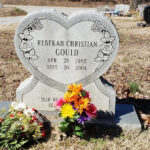Circumstantial Evidence Could Bring Rebekah Gould’s Killer to Justice
- By dc
- In In the Media, Media
- 0 comment
By Jennifer Bucholtz, Faculty Member, Criminal Justice and Forensic Science at American Military University
Editor’s Note: This is the eighth article in a series reviewing and analyzing the facts and evidence related to the murder of Rebekah Gould. Read the first article to learn about the facts of the case, forensic evidence, and the means, motive, and opportunity of the killer. Read the second article for more analysis about the murder weapon, the crime scene, and location where Rebekah’s body was found. Read the third article for new revelations and information discovered by the author during her visit to the area where Rebekah was murdered. Read the fourth article analyzing new evidence to help identify her killer. Read the fifth article analyzing her autopsy report. Read the sixth article that answers reader’s questions. Read the seventh article that utilizes geographic profiling and psychology to gain insight to the mind of the killer.
My previous seven articles, as noted above, discuss and analyze the known facts of the murder of Rebekah Gould more than 14 years ago. The collected information can be used to build a strong circumstantial case against the killer. I believe the evidence and information in this case would hold up in court and prove who the killer is beyond a reasonable doubt—the requirement for a jury to convict someone.
Below are the circumstantial conclusions I have drawn based on my analysis of the known facts:
Probable Time of Death
Rebekah was last seen in public between 8:00 and 8:30 a.m. on Monday, September 20, 2004. This was verified by video recorded at the Possum Trot convenience store in Melbourne, Arkansas. She was due to pick up her sister to drive to Fayetteville around noon that day, which puts her probable time of death between 8:30 a.m. and noon.
She Likely Knew Her Killer
I believe Rebekah knew her killer. I can’t say for sure why she was only wearing a t-shirt and underwear when her killer arrived at Casey McCullough’s house to confront her. She may have been napping, changing clothes, or preparing to get in the shower. The assumption that she did not scramble to put pants on when her killer arrived is an important indication that her killer was probably someone she knew well and trusted.
The Probable Scenario
Many have speculated that Rebekah and her killer engaged in a verbal argument the morning she was murdered, before she stopped at the Possum Trot. This may be true, but I don’t think it was the primary motive for the perpetrator to come to Casey’s house to kill her. Instead, I believe he either received a phone call or somehow obtained information from another person (maybe at work) that indicated Rebekah had done something he did not approve of, such as spend time with another man. Maybe she had become intimate with someone new, or maybe she had simply been seen with another man and that information was relayed to her killer. Whatever the motive was, it was something that flipped a light switch in the killer’s mind and sent him into a rage. He may have even showed up at Casey’s house expecting to find another man there. Upon arriving at Casey’s house, the killer probably confronted Rebekah with the recently discovered information and a verbal argument ensued. The argument likely escalated, leading the killer to snatch a weapon of opportunity and hit Rebekah twice with it.
The Clean Up
Whoever killed Rebekah spent some time at the murder scene cleaning, most likely right after he took her body outside and placed it in a vehicle. This would have been the least risky time to conduct a clean-up because no one yet knew Rebekah was missing, therefore, no one would come to Casey’s house to look for her.
If the killer had waited until a later time to return to the scene and clean up, it would have greatly increased the risk of being caught. This is because he wouldn’t have known when Rebekah would officially be reported missing to authorities or when the house might be searched by law enforcement.
The killer probably used towels from the house to clean up the majority of visible blood. In the process of cleaning, he removed the bloody sheets from the bed, flipped the mattress over so the blood stain would not be visible during a rudimentary search, and hid the bloody pillows under the bed. Before leaving the house that morning, he probably put the bloody towels in the washer and started the cycle.
I suspect this initial clean-up was rushed because the killer had a schedule or obligation to meet in order to have an alibi. He may have even left work to confront Rebekah and knew he could not stay away from his place of employment for too long before someone would start questioning his whereabouts. He did only what was necessary so that if someone happened to stop by, they hopefully would not notice anything out of place.
I believe the killer planned to return to the house that night to clean it completely, dispose of all related evidence, wash the sheets, return them to the bed, and remove Rebekah’s belongings and vehicle from the property. He likely planned to do this in hopes that law enforcement would suspect Rebekah left of her own free will or had been kidnapped.
Moving Her Body
The killer probably transported Rebekah’s body from the crime scene to the disposal site very soon after he determined she was dead, or decided death was imminent. Logically, he would have removed her body from the house prior to starting the clean-up; moving her body after cleaning would have resulted in additional work.
Following the hasty clean-up, the killer likely drove Rebekah’s body the 15 or so minutes to the disposal site. He would not have risked leaving her body in his vehicle any longer than necessary. After disposing of her body, he probably returned to work or whatever obligation he had.
Who had the overwhelming motive to clean the crime scene and move Rebekah’s body?
Missed Opportunity to Finish Cleaning
I believe the killer missed his opportunity to return to the house in the middle of Monday night and finish cleaning because he fell asleep. When he awoke the next morning, he probably panicked at the realization that he failed to follow through on the task that would, in his mind, remove any trace of Rebekah’s murder from Casey’s house.
Despite his missed opportunity, indications are that he still took a huge risk and returned to the scene. I believe this was the case because the towels were reported to have been found in the dryer and the bloody sheets in the washer. Unless the killer spent a longer period of time during the initial clean-up on Monday to wait for the towels to wash, it’s probable he came back to the house on Tuesday morning to put the towels in the dryer and start a new wash cycle for the sheets. For whatever reason, he was unable to finish cleaning or wait for the sheets to complete the wash cycle. Maybe he was, yet again, expected to be at work.
My hunch is that when he returned to the house on Tuesday morning, the killer forgot about the bloody pillows stuffed under the bed because they were not in plain sight. Even if he had completed a full clean-up, law enforcement’s discovery of the pillows would have confirmed that Rebekah had been assaulted in Casey’s house.
The Importance of the Laundry
Casey McCullough stated that the responding officer who conducted the welfare check on Tuesday morning opened the washing machine. This fact bothered me for a long time. I would not expect a police officer conducting a welfare check, searching for a human being, to look in a washer. A grown adult, even at Rebekah’s small size, would not fit in a washing machine.
I suspect that officer opened the washing machine because he heard the noise of it running. If I am correct, that means the killer had been at Casey’s house within the previous hour or so (probably less than an hour) prior to the welfare check to start that load of laundry. I am confident the killer, himself, did this because all reports indicate that the sheets from Casey’s bed, with Rebekah’s blood on them, were found in the washing machine. No one except the killer would have had the motive to return to Casey’s house and start another load of bloody laundry.
Who would have felt comfortable taking the immense risk of returning to the scene of the crime, nearly 24 hours after it occurred, to do laundry?
Lack of Foreign DNA and Fingerprints
Whoever killed Rebekah and cleaned the scene had to touch many surfaces and items in various rooms of the house. He had to move her body, kneel down to wipe blood off the floors, put laundry in the washer, and, at some point, probably had to wash his hands in one of the sinks or maybe even shower. There is a very good chance the killer would have left traces of his own DNA or fingerprints at the scene. This is especially true because it’s doubtful he brought any gloves or protective gear as a forethought because there is no indication the murder was pre-meditated and planned out.
Though the Arkansas State Police refuse to disclose any of the investigative documents, there is at least one logical deduction we can make without it. That is, that there was no foreign DNA or fingerprints found at the crime scene. “Foreign” DNA and fingerprints refers to that of a person who is not normally associated with a particular location. In this case, that location is Casey’s house. Certainly, Casey and Rebekah’s DNA and fingerprints were strewn throughout the house since they both lived there. The DNA and fingerprints of Casey’s father, who had a bedroom at the house, would not have been out of place either.
If the DNA and/or fingerprints of someone who had no reason to be at the house had been found, that person should have been arrested. Some of the persons of interest in this case are convicted felons, though none were at the time of the murder. That means their DNA profiles are now in the Combined DNA Index Database (CODIS). Assuming law enforcement has periodically submitted this unknown DNA to CODIS over the past 14 years, they would have been able to make a match had those persons’ DNA been found at the crime scene. The lack of an arrest indicates to me that there was no foreign DNA or fingerprints collected from the house.
Additional Circumstantial Criteria
The above discussion provides some very convincing evidence which points away from most of the suspects. In evaluating who was the most likely person to carry out this murder, the following list of additional circumstantial items needs to be considered as well. The killer would need to meet all the circumstantial criteria on this list:
- An alibi that is impossible to prove.
- Admitted that he was at Casey’s house on Tuesday morning.
- DNA and fingerprints that would not look out of place in Casey’s house.
- A history of a personal and intimate relationship with Rebekah.
- A history of violent outbursts.
- Access to a vehicle.
- Knowledge of the local area.
- A first-hand changing timeline of events.
- An inability (i.e., refusal) to remember key pieces of the timeline prior to Rebekah’s murder.
- Access to Casey’s house and backyard, on two different days, without looking out of place.
- A lack of interest in searching for Rebekah’s body or attending her funeral.
- Knowledge of the loose piano leg if it was used as the murder weapon.
- Familiarity with both Rebekah’s and Casey’s dogs.
- A refusal to discuss his theory on what happened to Rebekah.
- Trust from Rebekah for her to remain in her underwear in his presence.
- Lived in the area depicted on this map.
What person fits all of the circumstantial criteria on this list?
Is Circumstantial Evidence Enough to Prove This Case?
There are many prosecutors and law enforcement personnel who believe there must be solid forensic evidence to convict someone of murder. However, Kelly Siegler from the popular show “Cold Justice” provided a fantastic analogy of the power of a circumstantial case: If you hold one pencil in your hand, it is easy to snap it in half. But, if you have a fistful of pencils you cannot break them. The same holds true for circumstantial evidence in court. One piece of circumstantial evidence is easy to contest and disprove. However, many pieces of circumstantial evidence that all point to the same person are very difficult to refute. When analyzing Rebekah’s case, we have a lot of pencils.
I’ve laid out a solid circumstantial case throughout this series of articles. If prosecutors combine this with whatever is in the investigative file, they ought to have a bulletproof case. They may not even need to try the case, as the killer may finally confess if presented with all this overwhelming evidence.
Final Thoughts
This is my last planned article in the series on the murder of Rebekah Gould. By no means, however, is the effort to bring justice to this case complete. The conclusions contained in this article, along with other pertinent, but confidential, information has been presented to the Arkansas State Police, district prosecuting attorney, Lieutenant Governor, and representatives from outside agencies, including the FBI. I am confident that the collaboration between these various investigative groups will bring crucial developments to the investigation and result in an arrest. I will continue to update readers, as allowed, on the progress of the case.
If readers have any information, no matter how inconsequential they believe it might be, please call the Izard County sheriff’s department at (870) 368-4203 or Arkansas State Police at (800) 553-3820. Tips can also be sent to info@asp.arkansas.gov or info@icuinvestigations.net. Anyone reporting information has the right to remain anonymous.
To learn more about current research into this cold case, read the next article in this series:
- Using Behavioral Analysis to Narrow Suspects in Rebekah Gould’s Murder
- Arrest Made in 16-Year-Old Murder Case of Rebekah Gould
About the Author: Jennifer Bucholtz is a former U.S. Army Counterintelligence Agent and a decorated veteran of the Iraq and Afghanistan wars. She holds a Bachelor of Science in criminal justice, Master of Arts in criminal justice and Master of Science in forensic sciences. Bucholtz has an extensive background in U.S. military and Department of Defense counterintelligence operations. While on active duty, she served as the Special Agent in Charge for her unit in South Korea and Assistant Special Agent in Charge at stateside duty stations. Bucholtz has also worked for the Arizona Department of Corrections and Office of the Chief Medical Examiner in New York City. She is currently an adjunct faculty member at American Military University and teaches courses in criminal justice and forensic sciences. Additionally, she is a licensed private investigator in Colorado. You can contact her at Jennifer.Bucholtz@mycampus.apus.edu.
- Share:
You may also like
Presenting the Rebekah Gould murder Case at CrimeCon 2021
- June 24, 2021
- by dc
- in In the Media

The Myth of Misinformation

A CLOSER LOOK: the murder mystery of Rebekah Gould




